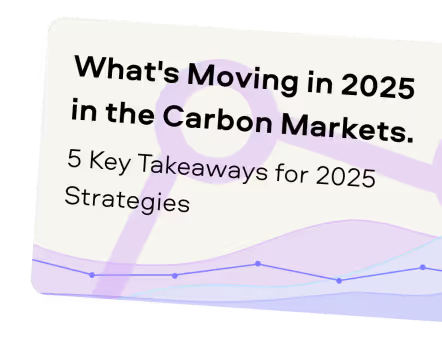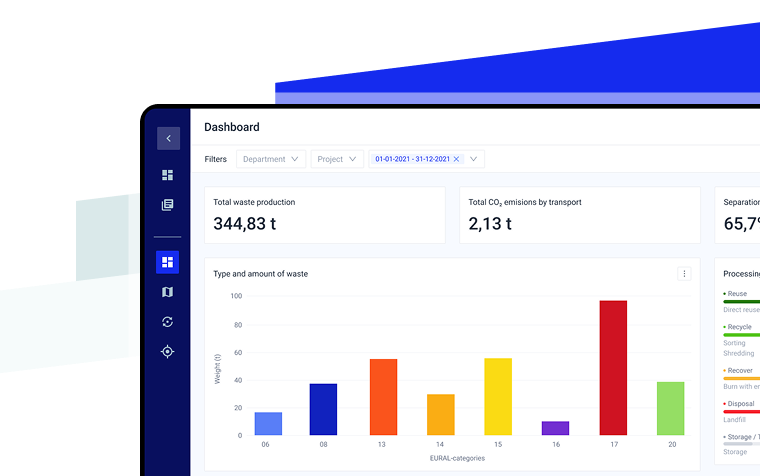“Over the years we’ve invested significantly in our field data team - focusing on producing trusted ratings. While this ensures the accuracy of our Ratings, it doesn’t allow the scale across the thousands of projects that buyers are considering.”
For more information on carbon credit procurement trends, read our "Key Takeaways for 2025" article. We share five, data-backed tips to improve your procurement strategy.

One more thing: Connect to Supply customers also get access to the rest of Sylvera's tools. That means you can easily see project ratings and evaluate an individual project's strengths, procure quality carbon credits, and even monitor project activity (particularly if you’ve invested at the pre-issuance stage.)
Book a free demo of Sylvera to see our platform's procurement and reporting features in action.
Why Scope 3 Emissions Are So Difficult to Reduce
Scope 3 emissions include everything that happens outside your own operations — from the goods and services you buy to how products are used and eventually disposed of. Reducing these emissions is difficult because they sit beyond your direct control. They occur in your supply chain or in how customers use and dispose of your products. Even when the main sources are known, companies often depend on hundreds of suppliers — each with their own systems, data quality, and incentives. Changing supplier behaviour or material choices takes time, renegotiation, and sometimes higher short-term costs.
Another barrier is data uncertainty. Without verified and comparable information from suppliers and waste partners, it’s hard to know which actions genuinely reduce emissions — or to prove that reductions are real.
Finally, systemic complexity plays a major role. Materials, logistics, and waste chains are global and interconnected. Reducing emissions in one area (for example, by using recycled materials) can increase them elsewhere (through higher transport or energy intensity). True progress requires coordinated change across procurement, operations, design, and suppliers — not just better reporting.
Meanwhile, stakeholder and disclosure expectations are increasing. Customers, investors, and regulators now expect companies to understand and act on their full value-chain impact regarding greenhouse gas emissions . Those that can’t demonstrate credible progress risk compliance gaps, weaker supplier relationships, and lost tenders.
The Biggest Sources of Scope 3 Emissions in Waste & Materials
Scope 3 emissions are categorized by the World Resources Institute into 15 upstream and downstream categories, covering everything from purchased materials and transportation to employee commuting and investments. The relevance of each category depends on a company’s industry, products, and supply chain.
In this article, we focus on the four categories that matter most for waste and material-related emissions: purchased goods and services, waste generated in operations, end-of-life treatment of products, and logistics.
Purchased goods and services
These are the emissions embedded in the materials, components, and services a company buys. Whether it’s metals, plastics, packaging, or chemicals, every input has an upstream footprint. Choosing recycled or lower-carbon alternatives, or reducing overall material use and energy consumption , can make a significant difference.
Waste generated in operations
Every tonne of waste has a climate cost — from collection and transport to treatment or disposal. Emissions vary widely depending on what happens to that waste: landfill, incineration, or recycling. Tracking and improving these flows is one of the most direct ways companies can influence their Scope 3 impact.
End-of-life treatment of sold products
Once products leave your site, their eventual disposal also counts toward Scope 3. Whether they are reused, recycled, or landfilled determines their carbon impact. Designing for easier disassembly, reuse, or recovery reduces these downstream emissions.
Transport and logistics
The movement of materials — both inbound and outbound — adds another layer of emissions. Long supply chains, partial truckloads, or inefficient routes increase fuel use and carbon intensity. Optimising logistics or sourcing closer to production sites can lower both emissions and costs.
Together, these four areas explain why waste and material management are at the heart of most companies’ Scope 3 strategies. They’re also where accurate, verified data — like that captured and standardised through geoFluxus — can turn reporting into real reduction.
Practical Strategies to Reduce Indirect Emissions
Reducing Scope 3 emissions from waste and material use isn’t about doing everything at once — it’s about focusing on the biggest levers that create measurable impact. The six strategies below combine operational improvements, supplier collaboration, and better data to make reductions real and verifiable.
1. Minimise Waste and Improve Material Efficiency
One of the most effective ways to cut emissions is to use fewer materials. Every kilogram saved avoids upstream emissions from extraction, processing, and transport — and prevents waste downstream. Even small design or process changes can deliver measurable reductions.
KPI: Waste per unit of output.
geoFluxus: Visualises waste flows across all sites and suppliers to identify where materials are being lost and where inefficiencies occur — helping organisations prioritise where to act first and verify the results of every change.
2. Source Recycled and Low-Carbon Materials
Switching from virgin to recycled or lower-carbon materials reduces emissions immediately. This includes metals, plastics, and packaging — or alternative materials with smaller footprints.
KPI: Share of recycled or certified low-carbon inputs.
geoFluxus: Shows which materials end up in your waste streams and where the hotspots are, so you can spot opportunities to reduce, substitute, or increase recycled content upstream.
3. Engage and Collaborate with Suppliers
Building transparency through shared data, consistent reporting formats, and joint reduction targets improves both accuracy and accountability.
KPI: Percentage of suppliers providing required data.
geoFluxus: Brings together waste and material data from multiple suppliers and processors, standardises formats, and flags inconsistencies — helping teams build a more complete and verifiable Scope 3 picture.
4. Embed Circular Procurement Practices
Procurement teams can accelerate circularity by prioritising suppliers and products that enable reuse, repair, or take-back schemes. Embedding these principles helps reduce waste and increase recovery rates across the value chain.
KPI: Percentage of suppliers with circular options; landfill diversion or recovery rate.
geoFluxus: Maps where waste materials actually go — showing which partners recover, recycle, or landfill specific streams. These insights help procurement teams identify high-performing suppliers and track circular outcomes over time
5. Optimise Logistics and Material Transport
Moving materials and waste over unnecessarily long distances contributes to avoidable emissions. Sourcing closer to production and processing waste nearer to its point of generation can reduce both carbon and cost.
KPI: CO₂ per tonne transported; average transport distance per material.
geoFluxus: Highlights inefficient waste transport by mapping routes and linking them to emissions data, helping teams identify where logistics can be simplified or improved.
6. Automate and Verify Scope 3 Data
Reliable data is the foundation of credible reporting and real reductions. Automating how waste and material information is collected and verified improves consistency, reduces manual effort, and builds confidence in reported results.
KPI: Time spent on collecting and verifying data; frequency of data updates.
geoFluxus: Consolidates waste data from suppliers and waste partners, standardises formats, flags inconsistencies, and links every record to its original source for full traceability.
How Frameworks Drive Scope 3 Action
Companies are under growing pressure to understand and report their full value-chain emissions. Frameworks such as the Greenhouse Gas Protocol and emerging sustainability reporting standards make Scope 3 disclosure part of mainstream ESG practice.
It’s a daunting challenge — complex, data-heavy, and dependent on many stakeholders to provide accurate and trustworthy information. These frameworks define what needs to be measured, but not how to do it. As a result, many sustainability teams find themselves spending more time gathering and validating data from suppliers, waste partners, and logistics providers than actually reducing emissions.
Real-World Examples of Scope 3 Action
Retail and FMCG – Tesco’s Science-Based Targets for Scope 3
Tesco has committed to becoming net zero by 2050 and to cutting Scope 3 emissions by 17% by 2030 from a 2015 baseline. The target covers purchased goods and services, fuel and energy use, transport, and waste.
A full supply-chain footprint survey revealed that agriculture and food manufacturing drive most of Tesco’s supply-chain impact, leading to dedicated reduction plans for those areas. Since 2006, the retailer has invested £700 million in efficiency and switched to 100% renewable electricity in the UK and Ireland.
By combining efficiency, renewable energy, and supplier collaboration, Tesco has turned its science-based targets into a practical roadmap for reducing Scope 3 emissions across one of the world’s largest retail supply chains.
https://sciencebasedtargets.org/companies-taking-action/case-studies/tesco
Chemical Industry – Tackling Scope 3 with Value-Chain Transparency
According to Deloitte, for the average chemical producer, Scope 3 emissions make up over 75% of total emissions — with 50.3% coming from upstream activities and 25.8% from downstream. Just three categories account for 65% of this footprint:
- Purchased goods and services – mainly emissions from feedstocks and raw materials.
- Use of sold products – such as fertilizers or refrigerants that release emissions during use.
- End-of-life treatment of sold products – including landfilling, incineration, or recycling.
Because most of these emissions occur outside direct operations, leading companies are investing in supplier collaboration, product redesign, and transparent data systems to trace and reduce them. For the chemical sector, Scope 3 progress starts with mapping the full product lifecycle — from feedstock to end-of-life — and acting where emissions are most concentrated.
Universities and Municipalities: Data gaps and collaboration opportunities
At Yale University, carbon emissions from Scope 3 made up about 57% of its total footprint in 2022. Measuring them proved complex, with thousands of sources across categories like purchased goods and services, capital goods, waste, travel, and commuting — plus a self-defined student travel category.
Yale focused on its largest contributor, purchased goods and services, using spending data to identify key suppliers and begin conversations about sustainability and emission reductions. Instead of chasing perfection, the university adopted a phased approach, improving data quality and supplier collaboration over time.
The result: clearer visibility into high-impact categories and a foundation for long-term, measurable reductions — showing that real Scope 3 progress starts with engagement and practical steps, not perfect data.
https://sustainability.yale.edu/explainers/yale-experts-explain-scope-3-emissions
Conclusion
Reducing Scope 3 emissions from waste and material use isn’t just a technical challenge — it’s a test of visibility, collaboration, and consistency. The examples across retail, manufacturing, and academia all point to the same truth: real progress starts when organisations can see where their emissions come from, compare suppliers on verified data, and focus effort where it makes the biggest difference.
Whether it’s Tesco mapping agricultural hotspots, chemical producers redesigning value chains, or universities improving supplier dialogue, the path forward is built on credible data and shared accountability.
Tools like geoFluxus make that possible by transforming fragmented waste data into one connected system — showing where resources move, where emissions arise, and where reductions can be achieved.
Companies that invest in this visibility today will be the ones driving measurable, verifiable Scope 3 reductions tomorrow — turning reporting from a compliance exercise into a real lever for circular, low-carbon growth.
Ready to see how?
Book a demo to explore how geoFluxus can help you measure, report, and reduce Scope 3 emissions with confidence.
FAQs
What are Scope 3 emissions in simple terms?
Scope 3 emissions are the indirect greenhouse gas (GHG) emissions that occur throughout a company’s entire value chain — both upstream and downstream. They include everything from the production of raw materials and purchased goods and services to waste generated, business travel, and employee commuting. Unlike direct emissions (Scope 1) or those from electricity and energy use (Scope 2), Scope 3 covers all the activities a company influences but doesn’t directly control.
What are the biggest sources of Scope 3 emissions?
The largest contributors depend on the industry and business model, but common sources include purchased goods and services, transport and logistics, waste generated in operations, and the end-of-life treatment of sold products. For manufacturers, emissions from raw materials, supply chains, and production processes often dominate the company’s overall carbon footprint. Together, these categories make up a significant share of global emissions data and represent the biggest emissions reduction opportunities.
How can companies reduce Scope 3 emissions in waste and materials?
The most effective actions include improving material efficiency, sourcing low-carbon or recycled materials, embedding circular economy practices, and collaborating with suppliers through clear procurement processes.
What frameworks and standards guide Scope 3 reporting?
The Greenhouse Gas Protocol defines how to report emissions across all three scopes, while the Science Based Targets initiative (SBTi) helps companies set net-zero targets and align reductions with efforts to limit global warming. These frameworks define what needs to be measured, but not how to measure it — which is why many organisations now rely on digital platforms to standardise data collection, ensure consistency in emission factors, and improve environmental sustainability performance across their supply chains.
How does geoFluxus support Scope 3 reporting and reduction?
geoFluxus helps companies gather and verify waste and waste transport emissions data across all sites and suppliers. It maps where waste is generated, how it’s treated, and the related carbon intensity and total emissions of each route — from transport to end-of-life treatment. By linking verified GHG emission factors to real data, geoFluxus turns reporting into a practical management tool, helping organisations identify emissions reduction opportunities, optimise procurement decisions, and advance their environmental sustainability goals.









